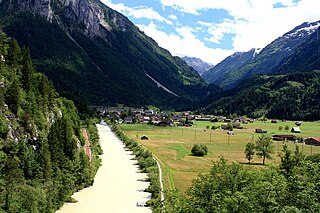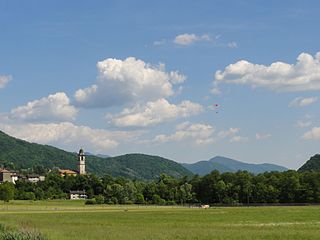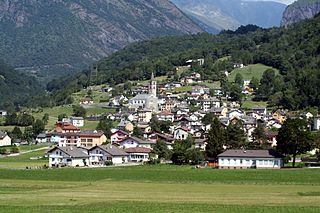Related Research Articles

Saanen is a municipality in the canton of Berne in Switzerland. It is the capital of the Obersimmental-Saanen administrative district.

Aranno is a municipality in the district of Lugano in the canton of Ticino in southern Switzerland. Bordering municipalities are Cademario, Iseo, Alto Malcantone, Miglieglia and Novaggio.

Lumnezia is a valley region and a municipality in the Surselva Region in the Swiss of canton of Graubünden. The former municipalities of Cumbel, Degen, Lumbrein, Morissen, Suraua, Vignogn, Vella, and Vrin merged on 1 January 2013 into the new municipality of Lumnezia. It covers the (Val) Lumnezia, a Swiss high alpine valley. Its upper regions are among the most remote areas in the Swiss Alps. The official language is Romansh Sursilvan.

Innertkirchen is a village and municipality in the Interlaken-Oberhasli administrative district in the canton of Bern in Switzerland. On 1 January 2014 the former municipality of Gadmen merged into the municipality of Innertkirchen.

Olivone was a municipality in the district of Blenio in the canton of Ticino in Switzerland.

Gerra (Verzasca) is a part of the municipality of Cugnasco-Gerra in the district of Locarno in the canton of Ticino in Switzerland.

Alto Malcantone is a municipality in the district of Lugano in the canton of Ticino in Switzerland. It was formed on 13 March 2005 from the earlier municipalities of Arosio, Breno, Fescoggia, Mugena and Vezio.

Astano is a municipality in the district of Lugano in the canton of Ticino in Switzerland.

Curio is a municipality in the district of Lugano in the canton of Ticino in Switzerland.

Sessa is a municipality in the district of Lugano in the canton of Ticino in Switzerland.
Fescoggia is a village and former municipality in the canton of Ticino, Switzerland.
Mugena is a village and former municipality in the canton of Ticino, Switzerland.
Vezio is a village and former municipality in the canton of Ticino, Switzerland.
Arosio is a village and former municipality in the canton of Ticino, Switzerland.

Alpine transhumance is transhumance as practiced in the Alps, that is, a seasonal droving of grazing livestock between the valleys in winter and the high mountain pastures in summer. Transhumance is a traditional practice that has shaped much of the landscape in the Alps, as without it, most areas below 2,000 m (6,600 ft) would be forests. While tourism and industry contribute today much to Alpine economy, seasonal migration to high pastures is still practiced in Bavaria, Austria, Slovenia, Italy and Switzerland, except in their most frequented tourist centers. In some places, cattle are taken care of by local farmer families who move to higher places. In others, this job is for herdsmen who are employees of the cooperative owning the pastures.

Blenio is a municipality of the district of Blenio, in the canton of Ticino, Switzerland.

Fusio is a village and former municipality in the district of Vallemaggia in the canton of Ticino, Switzerland.

Gambarogno is a municipality in the district of Locarno in the canton of Ticino in Switzerland. It was created on 25 April 2010 through the merger of the municipalities of Caviano, Contone, Gerra, Indemini, Magadino, Piazzogna, San Nazzaro, Sant'Abbondio and Vira.

Monteceneri is a municipality in the district of Lugano in the canton of Ticino in Switzerland. It was created on 21 November 2010 through the merger of the municipalities of Medeglia, Bironico, Camignolo, Rivera and Sigirino.

Glarus Nord is one of three municipalities of the canton of Glarus, Switzerland.
References
- ↑ Amtliches Gemeindeverzeichnis der Schweiz published by the Swiss Federal Statistical Office (in German) accessed 14 January 2010
- 1 2 3 4 Breno in German , French and Italian in the online Historical Dictionary of Switzerland .
- Breno in German , French and Italian in the online Historical Dictionary of Switzerland .
Coordinates: 46°02′N8°53′E / 46.033°N 8.883°E
| This Ticino location article is a stub. You can help Wikipedia by expanding it. |